National Archives director is caretaker of history, transparency
- Share via
Reporting from Washington — Until recently, David Ferriero’s favorite artifact at the National Archives was the canceled $7.2-million check -- “an actual check!” -- that was used to purchase the territory of Alaska back in 1868.
But this month, Ferriero, the archives’ new director, saw an old American Indian treaty in a secret vault. It was etched on parchment and festooned with ribbons and, he recalled, “a string of the most beautiful cobalt blue and white beads.”
“Wampum!” he exclaimed in a recent interview. “Have you ever seen wampum?”
By now, Ferriero probably has a new favorite item. For the nation’s 10th archivist, the former director of New York’s public libraries, the discoveries come daily.
Ferriero, 64, began work in November as director of the National Archives and Records Administration and had his ceremonial swearing-in Jan. 13. He was inaugurated into a little-known job that puts him not only at the helm of the United States’ 10-billion-item trove of documents, but also at the forefront of efforts to make the U.S. government as transparent as possible to its citizens.
“One of our missions is to ensure people of the United States have access to the records,” said Ferriero, who is the first librarian to run the National Archives.
Beyond the so-called Charters of Freedom, written by the founding fathers, the National Archives holds old legislative bills, early sketches of the Apollo moon lander and formerly classified details on the attempted U.S. coverup of a U-2 spy plane that went down in the Soviet Union in 1960. There are decades of slave ship manifests, military records and immigration logs treasured by genealogists.
“The only way you can hold the government accountable is to have access to the way decisions are made, and the only way to do that is to have the records,” said Lee White, executive director of the National Coalition for History in Washington.
Ferriero worked his way up from shelving books to associate director of libraries at the Massachusetts Institute of Technology. He was Duke University’s vice provost for libraries from 1996 until 2004, before he took over the public libraries for New York City.
He delights in history and tries to wander every day through the National Archives’ rotunda, home to the Declaration of Independence and the Constitution, to marvel alongside the tourists.
Ferriero’s tenure follows a difficult time for the National Archives.
The agency fought the George W. Bush administration over access to records after the Sept. 11 terrorist attacks and was accused by the New York Times of needing “spine-stiffening” in its dealings with the White House.
In 2003, Samuel R. “Sandy” Berger, former national security advisor to President Clinton, took classified memos on terrorist plots from the National Archives and destroyed them. Berger later pleaded guilty to unauthorized removal of classified documents.
Asked recently whether he has the backbone to take on the White House over public records, Ferriero nodded.
“Oh, sure,” he said. “And it’s not just the White House. It’s the government in general. I need to make sure that each agency is doing what they’re supposed to be doing in the area of records. It’s an oversight role.”
For now, though, he remains awed by the near-daily encounters with history.
Recently, he visited the military records archives in St. Louis. There, he saw the vault that contained the records of Gen. George S. Patton, baseball great Jackie Robinson and rock legend Elvis Presley. In the same vault, he found another document, his own personnel records from his service in the Navy.
Maybe that is the national archivist’s new favorite artifact.
Barrett writes for McClatchy Newspapers’ Washington bureau.
More to Read
Sign up for Essential California
The most important California stories and recommendations in your inbox every morning.
You may occasionally receive promotional content from the Los Angeles Times.













